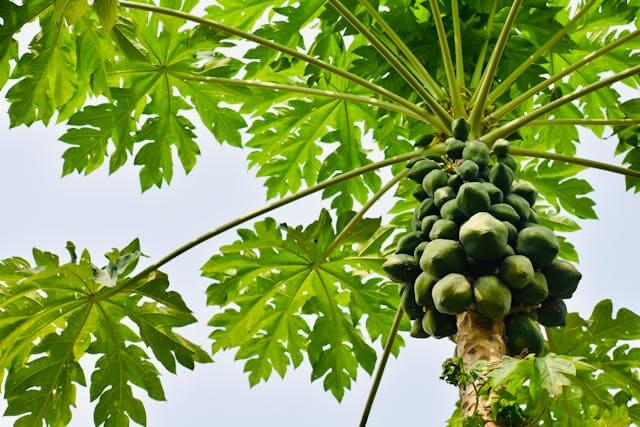The Papaya Tree (Carica papaya) is a tropical fruit tree known for its vibrant, sweet fruits that are enjoyed worldwide. Originating from Central America and Southern Mexico, papayas are now cultivated in various tropical and subtropical regions for their delicious flavor and nutritional benefits. The tree itself is relatively fast-growing and can reach up to 10 meters in height, with large, deeply lobed leaves and a single trunk topped by a cluster of fruits.
Papayas are not only valued for their taste but also for their rich content of vitamins, antioxidants, and enzymes like papain, which aids in digestion. The fruits are commonly used in salads, juices, desserts, and even as a tenderizing agent in meat dishes.
Top Farming Countries
Papaya trees thrive in warm climates with well-drained soil and ample sunlight. Some of the top countries known for papaya cultivation include:
- India: One of the largest producers of papayas globally, especially in states like Maharashtra, Karnataka, and Andhra Pradesh.
- Brazil: Significant production in states like Bahia and Espírito Santo.
- Indonesia: Known for its large-scale papaya farms in regions such as Java and Sumatra.
- Nigeria: Leading producer in Africa, particularly in the southwestern region.
- Mexico: The country of origin continues to be a major exporter, with production in states like Veracruz and Yucatán.
These countries benefit from the favorable climate conditions that support year-round cultivation, contributing significantly to global papaya supply.
Common Conditions and Diseases
Papaya trees are susceptible to various diseases and conditions that can affect their growth and fruit production. Some common ones include:
- Papaya Ringspot Virus (PRSV): Causes characteristic ring-shaped spots on leaves, leading to stunted growth and reduced fruit quality.
- Powdery Mildew: Fungal infection appearing as white powdery patches on leaves, affecting photosynthesis.
- Anthracnose: Fungal disease causing dark, sunken lesions on fruits, leading to fruit rot.
- Root Rot: Fungal infection of roots due to waterlogging or poor drainage, causing wilting and decline.
Homeopathy Medicine and Uses
Homeopathy offers natural remedies for managing various diseases and conditions in papaya trees. Here are some common remedies and their uses:
- Thuja occidentalis: Used for treating viral infections like PRSV in papaya trees. Symptoms include yellowing of leaves, ring spots, and stunted growth.
- Sulphur: Effective against powdery mildew, characterized by white powdery patches on leaves.
- Silicea: Helps in preventing and treating anthracnose, promoting resistance to fungal infections on fruits.
- Arsenicum album: Useful for managing root rot in papaya trees, especially in cases of wilting and decayed roots.
Fertilizers for Papaya Trees
Papaya trees require proper nutrition to support healthy growth, flower development, and fruit production. Depending on soil conditions and tree age, different fertilizers may be used throughout the year to ensure optimal nutrient balance. Here’s a breakdown of typical fertilizers and their applications for papaya trees:
1. NPK Fertilizers
NPK fertilizers are essential for providing the primary nutrients nitrogen (N), phosphorus (P), and potassium (K) in balanced proportions suitable for papaya trees:
- Nitrogen (N): Promotes vegetative growth and leaf development.
- Phosphorus (P): Supports root development, flowering, and fruit formation.
- Potassium (K): Enhances fruit quality, promotes disease resistance, and aids in overall plant vigor.
Application: Apply NPK fertilizers in split doses throughout the year, focusing on different growth stages:
- Young Trees: Apply a balanced NPK fertilizer (e.g., 10-10-10) every 2-3 months during the first year to establish root development and initial growth.
- Mature Trees: Use a higher potassium content fertilizer (e.g., 15-5-30) to support flowering and fruiting. Apply every 2-3 months during the fruiting season.
2. Organic Fertilizers
Organic fertilizers contribute to soil health and microbial activity, improving nutrient availability over time:
- Compost: Provides slow-release nutrients and improves soil structure. Apply annually around the base of the tree.
- Manure: Rich in nitrogen and organic matter. Apply during the rainy season or as a base fertilizer before planting.
- Organic Mulch: Helps retain soil moisture, suppresses weeds, and adds nutrients as it decomposes. Apply a layer around the tree base annually.
Application: Organic fertilizers can be applied as top dressing or incorporated into the soil to supplement NPK fertilizers, promoting long-term soil fertility and papaya tree health.
3. Microelement Fertilizers
Microelement fertilizers are essential for correcting specific nutrient deficiencies that can affect papaya tree growth and productivity:
- Iron (Fe): Corrects iron deficiency, visible as yellowing of young leaves (chlorosis).
- Zinc (Zn): Essential for flower and fruit development, especially in alkaline soils.
- Manganese (Mn): Supports enzyme activity and overall plant health.
Application: Apply microelement fertilizers as foliar sprays or soil amendments based on soil and tissue analysis results to correct deficiencies and improve nutrient uptake efficiency.
Steps to Prevention
Preventing diseases in papaya trees involves proactive measures to maintain tree health and vigor:
- Site Selection: Plant in well-drained soil with good air circulation to prevent fungal infections.
- Sanitation: Remove and destroy infected plant parts promptly to prevent disease spread.
- Pruning: Regularly prune to improve air circulation and sunlight penetration within the canopy.
- Nutrient Management: Ensure balanced nutrition with appropriate fertilization to strengthen tree immunity.
- Water Management: Avoid waterlogging and ensure adequate drainage to prevent root rot.
By implementing these preventive measures, growers can maintain healthy papaya trees and enhance fruit production.
Disclaimer: The information provided in this article is for educational purposes only and is not intended as a substitute for professional medical or agricultural advice. Always consult with a qualified healthcare provider or agricultural specialist for diagnosis, treatment, and management of diseases.
